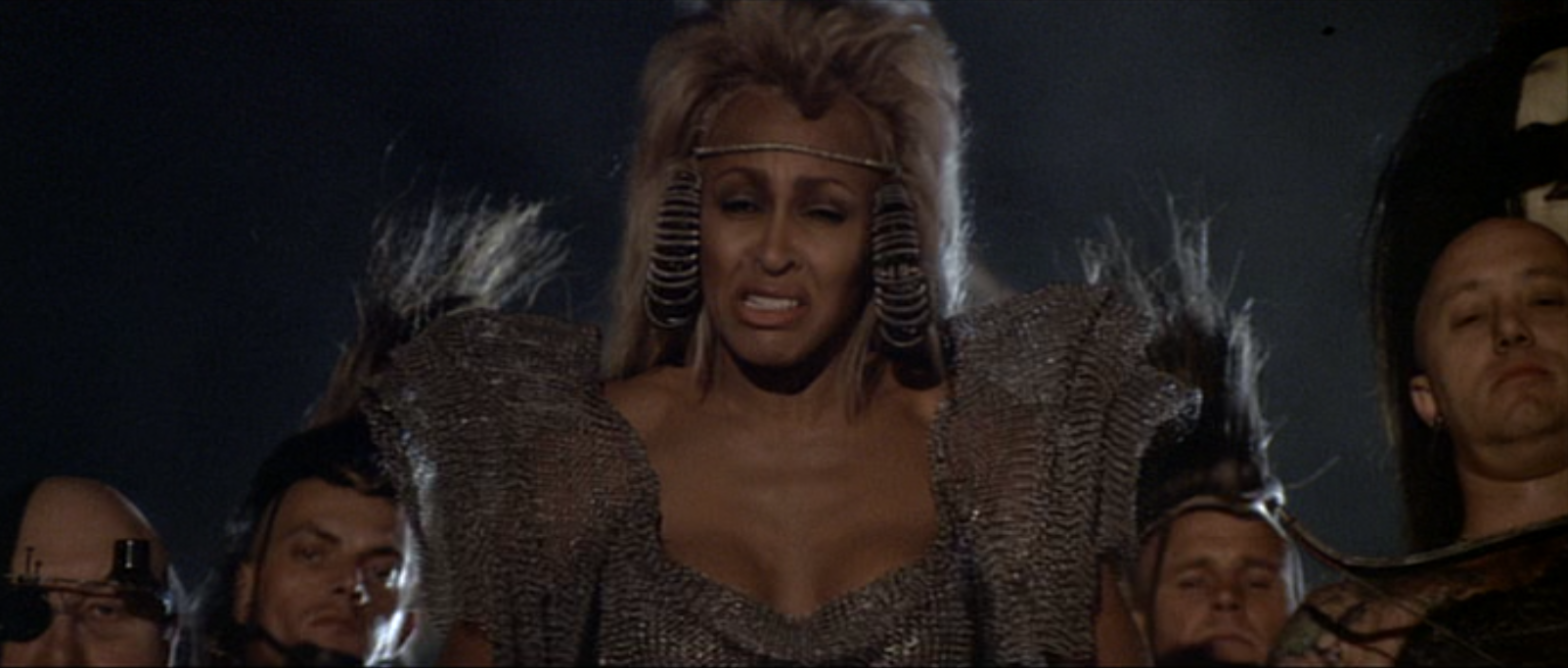Movie Review: Mad Max Beyond Thunderdome (1985) directed by George Miller
It has been a number of years since Max Rockatansky (Mel Gibson) somehow evaded the remainder of Lord Humungus’ raiders at the end of The Road Warrior. How many years? Uhh…look! He’s got camels now! And a monkey! But not for long, as an aviator named Jedediah (Bruce Spence) hijacks his wagon and leaves Max for dead. This being the beginning of the movie, Max survives, and makes his way to the nearby desert settlement of Bartertown. At first, it seems like he will be barred from admission because he has nothing to trade, but his quick reflexes impress the Collector (Frank Thring). Perhaps they can do business?

The nominal leader of Bartertown, Aunty Entity (Tina Turner), is in a power struggle with Master Blaster (Angelo Rossitto & Paul Larsson), a brains & brawn duo that control the town’s energy supply. The town needs Master’s engineering know-how, but he’s become arrogant, and without his powerful symbiotic ally, he’d be more…manageable. It can’t be a straight up assassination, Max is going to have to get Blaster to fight him one on one in the Thunderdome.
Max infiltrates the Underworld, where pig droppings are turned into methane fuel. He meets affable prisoner Pig Killer (Robert Grubb), who was sentenced to serve the pigs after he slaughtered one of them to feed his family. He also discovers Blaster’s secret weakness, while making an enemy of Master Blaster. Armed with this, it’s easy to goad Master Blaster into asking for a duel in the Thunderdome, where all violent disputes are settled.
“Two men enter, one man leaves.” Sounds simple, but the fight itself is much tougher than Max had thought, and when it comes right down to it, Max isn’t able to murder a helpless opponent. Aunty Entity considers this a violation of their contract, and the Wheel of Justice sentences Max to exile into “Gulag” without supplies.
On the verge of death, Max is found by a tribe of orphaned children, who’d been stranded in a gully that has enough water and vegetation to support life for a small group when their passenger jet crashed nearby. Most of the surviving adults, led by pilot Captain Walker, went off to look for help, promising to return for the children. (Any adults left with the children swiftly died themselves.) The kids think that Max is the long-awaited Captain Walker, who will take them to Tomorrow-Orrow Land.
Max makes it clear that he’s not, in fact, Captain Walker, there’s no better place waiting for the children, and he’d be just as happy staying in this nice safe gulch, thank you.
Frustrated, a number of the children, led by late teens Anna Goanna (Justine Clark) head out into the wilderness anyway. Max is forced by the remnants of his conscience to go after them with a few more tribe members. By the time the rescue party catches up, it’s too far to safely go back, so they will have to visit Bartertown. And that’s when things get particularly sticky.
This third Mad Max film started its script life as more of a children’s post-apocalyptic story about a man finding a lost tribe of orphans before director George Miller suggested Max as the lead and the more violent opening and closing parts were bolted on. This gives the movie an uneven tonal feel and the plot is even more vulnerable to falling apart if you think about it than the rest of the series.
That said, the Thunderdome fight is awesome, the vehicular combat portion is decent for the amount of time it has, and Tina Turner is excellent as Aunty Entity. She also contributes two nifty songs at the opening and closing credits.
The lost tribe of white children does again make me wonder if the aboriginal Australians are living comfortably somewhere off camera and avoiding getting caught up in all the plot nonsense.
I can understand why Miller and Gibson moved on from this series (though Miller returned some decades later), the ending of this third movie echoes the ending of the second just a little too closely, and it would have been hard to come up with a new story right away that would work. Plus Mel was beginning to want to be more in control of his movies.
Content note: Violence, often lethal, children in peril (at least one dies), the disability representation is iffy, pig shit.
Especially since Fury Road came along, this is the black sheep of the series, but if you can avoid thinking about the plot holes, it’s a decent watch for fans of Mel Gibson, Tina Turner, or the post-apocalypse setting.


I think dismissing the ending of Thunderdome as a retread of that of the Road Warrior does them both a bit of a disservice. With the former, we start to get hints that things are changing in the wasteland, that people are starting to rebuild rather than alternatively tear down or hide from those who might. It’s difficult to imagine Lord Humungus showing Max the clemency (or possibly cruel mercy) that Auntie Emnity shows him in their final encounter. And while the final scene has some echoes of the previous film, where we’re shown that this has all become a story told, there’s a subtle difference. Where the Feral Kid’s story concludes with the statement that he never saw Max again and suspects that he has probably died, Savannah’s telling expresses the sentiment that she hopes that someday, Max will find his way to them. A hope that even this profoundly damaged human being, as wounded as the world in which he lives, can eventually find peace.
You have some valid points.
R.I.P to Tina Turner!
Indeed!
You have some valid points.